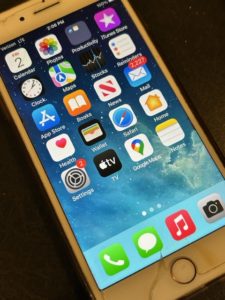 After Dorothy had enough of Emerald City’s glamour, good and bad witches, heroic stands against military-outfitted monkeys with wings and negotiations with third-rate wizards, she was reminded that she always possessed the power to fulfill her deepest desire – to go HOME.
After Dorothy had enough of Emerald City’s glamour, good and bad witches, heroic stands against military-outfitted monkeys with wings and negotiations with third-rate wizards, she was reminded that she always possessed the power to fulfill her deepest desire – to go HOME.
All she had to do was click her ruby red heels and chant “There’s no place like home. There’s no place like home.”
The songs of the season include this sentiment, too. One popular refrain tells us, “There’s no place like HOME for the holidays.”
In my personal life I have been grappling with the concept of HOME in a different sense. For weeks, I have struggled with the idea of retiring my iPhone 8 Plus even though the screen was cracked and I knew the model’s days qualifying me for technical support were numbered.
I had an unrealistic, actually limiting, attachment to my HOME button.
I wasn’t a natural swiper. It took me ages to figure out how to turn on my flashlight and close apps. (I often accomplished these tasks by accident then didn’t know how to replicate the result.)
I’m not quick, in general, to adapt to new technology. While promised conveniences and efficiency usually incent people to adapt to new technology, I never wanted to have my phone replace larger screens as the backdrop for information or to be my go-to device for watching movies.
I didn’t care if my phone did much more that allow me to order carry-out while running other errands and maintain an address book.
Swiping instead of pushing a button and an icon didn’t seem like a great advantage.
Completing a task as intended always seemed more important than speed. I rarely butt dialed. Trying to undo an action done in haste seemed like a bigger time suck.
Being present as I performed an operation always seemed more important.
I was very fond of the home button. Pressing it was like taking a deep restorative breath. I always thought of this pause as a decision to get grounded; to give myself a brief moment to get my bearings. Using my HOME button was like looking at a map or compass (remember them?) and affirming which direction was north.
But my attachment to my HOME button took on a symbolic sort of significance. I Googled around on why the HOME button was going the way of the rotary phone. It appears that it was a combination of technology and business — and the changing tastes of younger users.
Touchscreen technology emerged, supporting a different way to make choices, but eliminating this extra button also meant screens could be a half inch longer. This meant more apps could be displayed on a single screen.
Cha-ching. An attractive selling point for phone manufacturers vying for the increasing number of people who live on their phone.
I read that, on average, people spend over three hours a day on their smart phones. I also learned that I’m not the only person who misses the magic button. Other people have expressed that pressing a button has a different feel, a feel of certainty and completion, that dragging a fingertip over an icon just doesn’t provide.
I knew that, for me, it was not just the feel of pressing a button to know a task was completed. It was also the idea of starting from a place of familiarity.
I’m learning that it’s my capacity for accepting everything, not about being surrounded by a kitchen scent I loved when I was a child or the feel of flannel PJs on my skin, that allows me to feel “at home.”
The people I admire most are at HOME wherever they go. Being at HOME with yourself is being okay if nothing changes or if everything changes.
HOME is not a place or a button on a device.
This state of always being at HOME, starts with acceptance and naturally blossoms into love.
Carrying HOME in your heart is no small thing.


Leave a comment